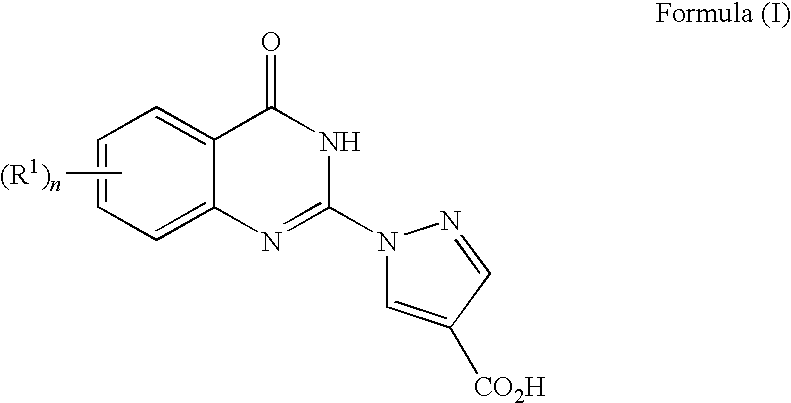Quinazolinones as prolyl hydroxylase inhibitors
a technology of prolyl hydroxylase and quinazolinone, which is applied in the field of quinazolinone compounds, can solve the problems of limiting the potential utility of vegf for the treatment of oxygen delivery disorders, affecting the ability of vegf to adapt to the metabolism and preservation of tissues, and affecting the effect of oxidative stress
- Summary
- Abstract
- Description
- Claims
- Application Information
AI Technical Summary
Benefits of technology
Problems solved by technology
Method used
Image
Examples
example 1
1-(7-Chloro-4-oxo-3,4-dihydro-quinazolin-2-yl)-1H-pyrazole-4-carboxylic acid
[0128]
[0129]Step A: Preparation of 7-chloro-1H-quinazoline-2,4-dione. A mixture of 2-amino-4-chlorobenzoic acid (2.00 g, 11.6 mmol) and urea (2.80 g, 46.6 mmol) was heated to 200° C. for 1 h. The mixture was allowed to cool to room temperature and the resulting mass was triturated well with water. The product was collected by filtration (2.30 g, 100%). The MS and NMR data are in agreement with those that have been previously described: Organic Process Research & Development, 2003, 7, 700-706. 1H NMR (600 MHz, DMSO-d6): 12.00 (br s, 2H), 8.59-8.53 (m, 1H), 7.93-7.80 (m, 2H).
[0130]Step B: Preparation of 2,4,7-trichloroquinazoline. A mixture of 7-chloro-1H-quinazoline-2,4-dione (2.0 g, 10 mmol) was suspended in ACN (50 mL), then POCl3 (5.0 mL, 55 mmol) was added. This was followed by addition of DIEA (5.0 mL, 28 mmol). The resulting mixture was heated to reflux for 36 h, and then allowed to cool to rt and conc...
example 2
1-(7-Trifluoromethyl-4-oxo-3,4-dihydro-quinazolin-2-yl)-1H-pyrazole-4-carboxylic acid
[0136]
[0137]The titled compound was prepared according to the methods described in Example 1 using 2-amino-4-trifluoromethylbenzoic acid in step A. MS (Cl): mass calcd. for C13H7F3N4O3, 324.2; m / z found, 323.0 [M−H]−. 1H NMR (400 MHz, DMSO-d6): 14.17-12.12 (br m, 2H), 8.98 (d, J=0.6 Hz, 1H), 8.32 (d, J=8.3 Hz, 1H), 8.29 (s,1H), 8.02 (s, 1H), 7.80 (d, J=8.3 Hz, 1H).
example 3
1-(6,7-Dichloro-4-oxo-3,4-dihydro-quinazolin-2-yl)-1H-pyrazole-4-carboxylic acid
[0138]
[0139]The titled compound was prepared according to the methods described in Example 1 using 2-amino-4,5-dichlorobenzoic acid in step A. MS (Cl): mass calcd. for C12H6Cl2N4O3, 325.1; m / z found, 323.0 [M−H]−. 1H NMR (500 MHz, DMSO-d6): 13.58-12.82 (br m, 2H), 8.92 (s, 1H), 8.28 (s, 1H), 8.21 (s, 1H), 7.96 (s, 1H).
PUM
| Property | Measurement | Unit |
|---|---|---|
| weight | aaaaa | aaaaa |
| temperature | aaaaa | aaaaa |
| temperatures | aaaaa | aaaaa |
Abstract
Description
Claims
Application Information
 Login to View More
Login to View More - R&D
- Intellectual Property
- Life Sciences
- Materials
- Tech Scout
- Unparalleled Data Quality
- Higher Quality Content
- 60% Fewer Hallucinations
Browse by: Latest US Patents, China's latest patents, Technical Efficacy Thesaurus, Application Domain, Technology Topic, Popular Technical Reports.
© 2025 PatSnap. All rights reserved.Legal|Privacy policy|Modern Slavery Act Transparency Statement|Sitemap|About US| Contact US: help@patsnap.com



